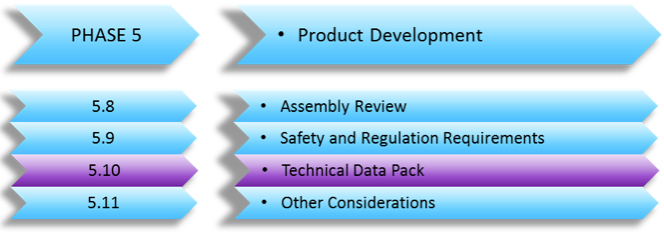 I wrote before about the importance of writing a product specification sheet. It is the bare minimum every importer should document.
I wrote before about the importance of writing a product specification sheet. It is the bare minimum every importer should document.
However, if you develop your own product and have it made in China, you should document additional technical data. And in some instances it is a requirement — for example, all CE marking directives require the manufacturer of the product to create a technical file.
As the importer, you are considered the manufacturer. You have to be able to demonstrate with appropriately detailed documentation, calculations and drawings, how your product complies with all relevant directives, and so is safe during all phases of its life. Let’s look at this here in phase 5.10.
(Don’t forget that you can see the whole series on developing a new product here.)
What needs to be in a technical data file?
As a general guide, the following items should be included (this is based on an example for an electro-mechanical product):
- Information concerning the products design assessment and construction, including information showing how relevant essential requirements have been met (which may include references to technical standards)
- Copy of the Declaration of Conformity (and any other Declarations of Conformity or Incorporation relevant to the product or its subassemblies)
- Description of the apparatus, usually accompanied by a block diagram
- Wiring and circuit diagrams
- General Arrangement drawing
- List of standards applied
- Records of risk assessments and assessments to standards
- Description of the control approach
- Datasheets for critical sub-assemblies
- Part list (Bill of Materials)
- Copies of any markings and labels
- Copy of instructions (user, maintenance, installation)
- Test reports
- Quality control & commissioning procedures
- Details of relevant research and test reports
- Where a series of products are made, details of the quality systems to assure the safety of those products.
In the European Union, the technical file does not have to be permanently available in material form but should be made available in a reasonable period of time if authorities ask for it (sources: hse.gov.uk; conformance.co.uk).
Technical Drawings
From a technical drawing point of view, certain features should be included in your product drawings. Each component should have its own drawing with enough detail to allow the Chinese manufacturer to produce it. Each part should be dimensioned accordingly, important dimensions should have specific tolerances applied, and some of these tolerances may have geometric tolerances applied to them.
A percentage of dimensions that are critical to quality or critical to functionality should be marked up as ‘critical dimensions’ or ‘critical to quality’ (CTQ).
These critical dimensions will need to be monitored and tracked throughout the manufacturing process (if possible through Statistical Process Control — you can read how to use statistical tools to improve production processes for more information).
The UK Department of Trade and Industry has published an interesting ‘National measurement good practice guide’. Here is an excerpt from that guide:
The purpose of an engineering drawing is to show the requirements of the design function, with clear and relevant information so that the product can be manufactured and inspected to those requirements. The methods used in the design process should be clear and concise so as not to cause ambiguity in the interpretation of the design and this should in turn allow everyone involved in the process to interpret the design.
Go to part 16: Packaging Considerations for your Product
Want to learn more about the new product introduction process for hardware startups?
Whether you’re some way along the process, or just starting out, Sofeast’s guide covers everything hardware startups need to know for making a new product in China and successfully bringing it to market.
Hit the button below to read the guide:


